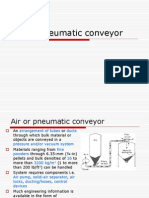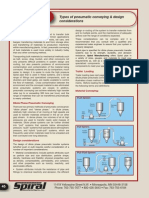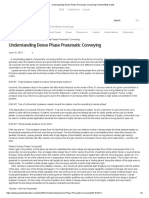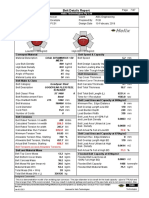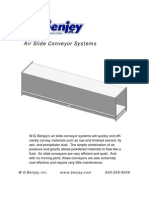100%(1)100% found this document useful (1 vote)
79 views6 Conveyor Pneumatic
6 Conveyor Pneumatic
Uploaded by
Rahmat RNThe document discusses various types of material handling equipment used in mechanical engineering, focusing on conveying machines. It describes several types of conveyors including belt conveyors, apron conveyors, flight conveyors, screw conveyors, roller conveyors, oscillating conveyors, and pneumatic conveyors. For pneumatic conveyors specifically, it outlines the key factors that determine system capacity and provides details on pressure systems, vacuum systems, and pressure-vacuum combination systems. It also presents nomographs and tables that can be used for the preliminary design of pneumatic conveying systems to estimate parameters like pipe diameter, air velocity, pressure drop, and power requirements.
Copyright:
© All Rights Reserved
Available Formats
Download as PPT, PDF, TXT or read online from Scribd
6 Conveyor Pneumatic
6 Conveyor Pneumatic
Uploaded by
Rahmat RN100%(1)100% found this document useful (1 vote)
79 views35 pagesThe document discusses various types of material handling equipment used in mechanical engineering, focusing on conveying machines. It describes several types of conveyors including belt conveyors, apron conveyors, flight conveyors, screw conveyors, roller conveyors, oscillating conveyors, and pneumatic conveyors. For pneumatic conveyors specifically, it outlines the key factors that determine system capacity and provides details on pressure systems, vacuum systems, and pressure-vacuum combination systems. It also presents nomographs and tables that can be used for the preliminary design of pneumatic conveying systems to estimate parameters like pipe diameter, air velocity, pressure drop, and power requirements.
Copyright
© © All Rights Reserved
Available Formats
PPT, PDF, TXT or read online from Scribd
Share this document
Did you find this document useful?
Is this content inappropriate?
The document discusses various types of material handling equipment used in mechanical engineering, focusing on conveying machines. It describes several types of conveyors including belt conveyors, apron conveyors, flight conveyors, screw conveyors, roller conveyors, oscillating conveyors, and pneumatic conveyors. For pneumatic conveyors specifically, it outlines the key factors that determine system capacity and provides details on pressure systems, vacuum systems, and pressure-vacuum combination systems. It also presents nomographs and tables that can be used for the preliminary design of pneumatic conveying systems to estimate parameters like pipe diameter, air velocity, pressure drop, and power requirements.
Copyright:
© All Rights Reserved
Available Formats
Download as PPT, PDF, TXT or read online from Scribd
Download as ppt, pdf, or txt
100%(1)100% found this document useful (1 vote)
79 views35 pages6 Conveyor Pneumatic
6 Conveyor Pneumatic
Uploaded by
Rahmat RNThe document discusses various types of material handling equipment used in mechanical engineering, focusing on conveying machines. It describes several types of conveyors including belt conveyors, apron conveyors, flight conveyors, screw conveyors, roller conveyors, oscillating conveyors, and pneumatic conveyors. For pneumatic conveyors specifically, it outlines the key factors that determine system capacity and provides details on pressure systems, vacuum systems, and pressure-vacuum combination systems. It also presents nomographs and tables that can be used for the preliminary design of pneumatic conveying systems to estimate parameters like pipe diameter, air velocity, pressure drop, and power requirements.
Copyright:
© All Rights Reserved
Available Formats
Download as PPT, PDF, TXT or read online from Scribd
Download as ppt, pdf, or txt
You are on page 1of 35
Mechanical Engineering Department
Gadjah Mada University
PROGRAM PENGEMBANGAN PROSES PEMBELAJARAN
UNTUK MENINGKATKAN SOFT SKILLS LULUSAN
Subject : Material Handling Equipment
(Pesawat Pengangkat dan Pengangkut)
Program Soft Skills
Large, moist, free flowing etc
CONVEYING MACHINES
Conveyor With Pulling Member:
1. Belt Conveyor **
2. Apron Conveyor (slat)
3. Flight Conveyor
Conveyor Without Pulling Member:
1.Screw Conveyor
2.Roller Conveyor
3.Oscillating &Vibrating Conveyor
4.Pneumatic & Hydraulic Conveyor
CONVEYING MACHINES
Conveyor Without Pulling Member:
Screw Conveyor: Trough, screw shape, shaft,
bearing, driving unit
Roller Conveyor: Roller, Frame work, speed
start etc
Oscillating &Vibrating Conveyor:
Trough, eccentric movement / cranksahaft,
frame work etc
Pneumatic & Hydraulic Conveyor:
Piping systems, pumps & blowers, feeder/intake
system, outlet chute etc
Bucket Elevator
Screw Conveyor
Roller Conveyor & Screw Conveyor
Pneumatic
Conveyor
PNEUMATIC CONVEYORS
• One of the most important material-handling techniques in the
chemical industry is the movement of material uspended in a stream of
air over horizontal and vertical distances ranging from a few to several
hundred feet.
• Materials ranging from fine powders through 6.35-mm
• (d-in) pellets and bulk densities of 16 to more than 3200 kg/m3 (1 to
more than 200 lb/ft3) can be handled.
The capacity of a pneumatic-conveying system depends on
(1) product bulk density (and particle size and shape to some extent),
(2)energy content of the conveying air over the entire system,
(3) Diameter of conveying line, and
(4) equivalent length of conveying line.
• Kapasitas minimum untuk pneumatik conveyor akan
dicapai jika tenaga dari udara carrier itu hanya cukup untuk
memindahkan padatannya saja melalui saluran tanpa
mengalami kemandegkan.
• Untuk mencegah kemandegan aliran bahan padat & udara
dalam saluran, dalam praktek yang bagus diperlukan
adanya tambahan energi udara sedemikian sehingga tidak
mengubah kualitas / karakteristik bahan padat yang
diangkut.
• Instalasi pneumatik conveyor dapat bersifat permanen
ataupun semi permanen .
• instalasi semi permanen misalnya pneumatik conveyor
yang disambungkan pada alat / kendaraan transpor padat
sistem bulk, yang menghendaki proses unloading bahan
dari kendaraan ke silo dengan cepat.
Types of Systems
Secara umum tipe pneumatic conveyor digolongkan menjadi 3 tipe dasar
• pressure system pneumatic conveyor,
• vacuum system pneumatic conveyor,
• combination pressure and vacuum pneumatic conveyor
Pressure systems pneumatic conveyor
• Dalam system ini bahan padat ditumpahkan ke massa aliran udara yang
meeiliki tekanan diatas atmosfer dengan rotary air-lock feeder
• Kecepatan dari arus udara mempertahan bulk material dalam bentuk suspensi
bahan padat dalam udara sampai bahan ini sampai ke alat / unit yang dituju,
dimana bahan padat itu dipisahkan dari udara dengan menggunakan
penyaring udara ataupun cyclonic .
• Pressure systems dipakai untuk free-flowing materials dari ukuran partikel up
to 6.35-mm (d-in) pellets, dimana kecepatan alir udara over 151 kg/min (20,000
lb/h) diperlukan dan dimana pressure loss / pressure drop melalui system
berkisar 305 mmHg (12 inHg).
• Systems ini lebih cocok jika satu sumber aliran padat + udara itu harus
dialirkan ke beberapa penerima (receiver tank).
• Udara pembawa pada system ini biasanya disupply oleh positive displacement
blower.
Vacuum systems
• Pada system ini ditandaai oleh bahaan padat bergerak
melalui aliran udara yang tekanannya lebih rendah dari
tekanan udara ambient.
• Keuntungan dari system ini adalah bahwa semua energy
pemompaan digunakan untuk menggerakan bahan
padatnya, sedemikan sehingga bahan padat dapat
dimasukan ke dalam conveyor line tanpa memerlukan
rotary feeder. Bahan padat dipertahankan tersuspensi
kedalam udara saampai udara bersama bahan padat itu
sampai ke reciver system antara lain cyclone separator
ataupun solid filter.Pada siklon ini bahan padat
dipisahkan dari
• System vakum secara tipikal dipakai jika aliran (udara +
bahan padat) tidak lebih dari 6800 kg/jam (15.000 lb/hour)
, dan panjang ekuivalent dari conveyor kurang dari 1000
ft (305 m).
• System ini dipakai untuk transpor bahaan padat yang
digolongkan finely divided materials
TABLE 21-12 Approximate Pneumatic-Conveyor Costs*
Conveyor pipe Power
Flow rate, inside diameter, required, Range of investment, $†
lb/h (kg/h) in (mm) hp Manual‡ Automatic§
10,000 (4,536) 4 (100) 25 83,000 46,000
25,000 (11,340) 6 (155) 60 135,000 89,000
50,000 (22,680) 6 (155) 125 200,000 155,000
100,000 (45,360) 8 (205) 200 356,000 312,000
Pressure-vacuum systems
• System ini merupakan kombinasi dari metode terbaik pressure
system dan vacuum system.
• Vacum digunakan untuk menarik material ke dalam conveyor
dan memindahkan material itu dalam jarak transpor yang
pendek sampai ke separator (filter / cyclonic separator).
• Udara yang keluar dari solid separator ini dimasukan
(disirkulasikan kembali ) ke bagian suction dari positive
displacement blower sehingga terjadi pressurized air (positive
pressure - air stream) keluar dari blower.
• Pressurized air ini kemudian dipakai untuk tranpor bahan padat
yang keluar dari rotary feeder pada solid separator bagian
bawah ke conveyor line ke unit / alat penerima.
Nomographs for Preliminary Design A useful set of
nomographs*for determining conveyor-design parameters is
given in Fig.21-13.
With these charts, conservative approximations of conveyor
size and power for given product bulk density, conveyor
equivalent length, and required capacity can be obtained.
Because pneumatic conveyors and their components are
subject to continual improvements by a fast-changing
upplier industry, manufacturers should be invited to submit
alternative designs to that resulting from the use of the
nomograph.
Some large users of pneumatic conveyors have found it
expedient to write computer programs for calculating
system parameters.
• Untuk mengawali perhitungan preliminary untuk
pnematic conveyor system , pertama adalah menentukan
panjang ekuivalent dari dari system yang dirancang.
• Panjang ekuivalent ini merupakan penjumlahan jarak
vertikal dan jarak horisontal saluran / conveyor line
ditambah panjang ekuivalent dari fitting pipa yang
dipakai.
• Fitting yang paling umum dipakai dalam pneumatic
conveyor system adalah long – radius 90o belokan pipa
(pipe elbow) dan 45o pipe elbow.
• Panjang ekuivalent dari long-radius 90°elbow pipe = 25 ft
(=7,6 m ) , sedangkan panjang ekuivalen dari 45° elbow
pipe = 15 ft (=4,6 m).
• Langkah kedua memilih kecepatan udara awal (trial &
error) menggunakan Table 21-13.
• Prosedur berhitung secara iterative dengan mengasumsi
diameter pipa yang dipakai untuk kapasitas tranpor dari
pneumatic system yang
TABLE 21-13 Air Velocities Needed to Convey Solids
of Various Bulk Densities*
Bulk density Air velocity Bulk density Air velocity
lb/ft3 kg/m3 ft/min m/min lb/ft3 kg/m3 ft/min m/min
10 160 2900 884 70 1120 7700 2347
15 240 3590 1094 75 1200 8000 2438
20 320 4120 1256 80 1280 8250 2515
25 400 4600 1402 85 1360 8500 2591
30 480 5050 1539 90 1440 8700 2652
35 560 5500 1676 95 1520 9000 2743
40 640 5840 1780 100 1600 9200 2804
45 720 6175 1882 105 1680 9450 2880
50 800 6500 1981 110 1760 9700 2957
55 880 6800 2072 115 1840 9900 3118
60 960 7150 2179 120 1920 10500 3200
Dengan mengacu pada Nomograph 1, gambarkan garis lurus antara air-
velocity dan skala diameter pipa , sedemikan sehingga jika garis ini
diperpanjang akan memotong garis acuan air-volume pada suatu titik
dibaca pada skala ?
Kembali ke Nomograph 2, posisikan skala air-volume dan kapasitas transpor
terhitung tadi , tarik garis lurus melewati dua titik ini dan garis akan
memotong garis skala acuan antara air-volume dan system capacity,
perpotongan ini akan mendapatkan nilai solid rasio (perbandingan antara
padatan dengan udara), jika solid rasio ini melebihi 15 , maka asumsikan
lagi diameter pipa yang lebih besar , demikian dst.
Mengacu nomograph 3 the pipe diameter and the air volume
Found in Nomograph 1, buat garis lurus dan garis ini akan memotong garis
acuan design factor dibaca skala design factor (P)
Dibaca berapa?
Dibaca ini berapa?
• Garis yang didapat tadi akan memotong garis acuan untuk
design factor dan pressure drop per 100 ft panjang
saluran.
• Angka design factor dan equivalen length dari saluran
pipa, kemudian ditarik garis lurus pada Nomograph 4 ,
maka akan memotong pivot line ditengah hubungkan
titik yg didapat pada pivot point ini dengan solids – ratio
(dari nomograph 2) akan didapat system presure drop .
• Jika system pressure drop ini melebihi 10 lb/in2 terlalu
besar.
• Maka asumsikan ulang ukuran diameter pipa yanag lebih
besar , dan ulangi mulai dari awal lagi sedemikan
sterusnya sehingga diperoleh pressure drop < 10 lb/in2.
• Setelah diperoleh diameter pipa yang memberikan
pressure drop < 10 lb/in2 , maka gunakan nomograph 5
untuk mendapatkan horse power yang diperluakan oleh
conveyor system.
Oscillating Conveyor
Vibrating conveyor &
AC motor
Vibrating Conveyor
Thank You
You might also like
- WBB Wat Set 20 08 2019Document59 pagesWBB Wat Set 20 08 2019David FrederickNo ratings yet
- Urea Granulation TechnologyDocument13 pagesUrea Granulation TechnologyRong RêuNo ratings yet
- Air or Pneumatic ConveyorDocument36 pagesAir or Pneumatic ConveyorAshish Sharma100% (2)
- Deven Aranha-Marine Diesel (Scanned) - 1Document202 pagesDeven Aranha-Marine Diesel (Scanned) - 1nirmal92% (12)
- T.E. Mechanical (A-4) MONIL DOSHI-0815054 KIRAN PATIL - 1125027 JIGAR SHAH - 0815045Document19 pagesT.E. Mechanical (A-4) MONIL DOSHI-0815054 KIRAN PATIL - 1125027 JIGAR SHAH - 0815045wahyuNo ratings yet
- WWW - Nol Tec - Com Documents Pdfs Answers To Eight Common QuestionsDocument6 pagesWWW - Nol Tec - Com Documents Pdfs Answers To Eight Common QuestionsIaponaira de Abreu100% (1)
- Misc Equipment ItemsDocument18 pagesMisc Equipment Itemshk168No ratings yet
- Vessel Conveyor SystemDocument4 pagesVessel Conveyor SystemleekiangyenNo ratings yet
- Materials Transfer: Types of Pneumatic Conveying & Design ConsiderationsDocument5 pagesMaterials Transfer: Types of Pneumatic Conveying & Design ConsiderationsRosa María Córdova100% (1)
- Pneumatic and Hydrautic Conveying of Both Fly Ash and Bottom AshFrom EverandPneumatic and Hydrautic Conveying of Both Fly Ash and Bottom AshNo ratings yet
- Pneumatic Transport: - Basic Definition - Using Gas To Transport A Particulate Solid Through A Pipeline - Two ModesDocument12 pagesPneumatic Transport: - Basic Definition - Using Gas To Transport A Particulate Solid Through A Pipeline - Two ModesCarloLopezNo ratings yet
- Is 4776 1 1977Document12 pagesIs 4776 1 1977retrospect1000No ratings yet
- Data Sheet For Rotary Valve VRT-301 Rev.1Document1 pageData Sheet For Rotary Valve VRT-301 Rev.1Long Ellery Pham0% (1)
- Text Dense PhaseDocument4 pagesText Dense PhaseZakir Hossain BiplobNo ratings yet
- Pipe Conveyor: Sheet 1 of 3Document3 pagesPipe Conveyor: Sheet 1 of 3Ravi KumarNo ratings yet
- Air Receiver TankDocument4 pagesAir Receiver TankHudaFiHayyatNo ratings yet
- Engineering Letter: PneumaticconveyingDocument4 pagesEngineering Letter: PneumaticconveyingMangatur SimamoraNo ratings yet
- Gas-Solid Flows: 2004 by Marcel Dekker, Inc. All Rights ReservedDocument36 pagesGas-Solid Flows: 2004 by Marcel Dekker, Inc. All Rights ReservedGustavo Hernandez100% (1)
- Estimation of Dust Suppression System WiDocument3 pagesEstimation of Dust Suppression System WiRopafadzo ChihuriNo ratings yet
- Mecawber DenseveyorDocument4 pagesMecawber DenseveyorkanthmekalaNo ratings yet
- Unloading Systems For Self Unloading Cement CarriersDocument17 pagesUnloading Systems For Self Unloading Cement CarriersGourav DubeyNo ratings yet
- A Quick Look at Pneumatic Convey Systems Basics-NOL-TECDocument3 pagesA Quick Look at Pneumatic Convey Systems Basics-NOL-TECStacy Wilson100% (1)
- Aptech Advances in Pneumatic Conveying EditorialDocument17 pagesAptech Advances in Pneumatic Conveying EditorialMinh Tú PhạmNo ratings yet
- Conveyor Transitions: Michael Cremeens, VP Business Development Member, NIBA Education/Technical Committee MemberDocument7 pagesConveyor Transitions: Michael Cremeens, VP Business Development Member, NIBA Education/Technical Committee MemberPanchoMiyamotoNo ratings yet
- Interstitial Velocity GuidelinesDocument6 pagesInterstitial Velocity GuidelinesnaushadNo ratings yet
- Pneumatic Powder Transport: by Erik Karlsen, M.SC., Ehk@tekfa - DK, TEKFA A/SDocument4 pagesPneumatic Powder Transport: by Erik Karlsen, M.SC., Ehk@tekfa - DK, TEKFA A/SjmauriciopfNo ratings yet
- 3223some Issues of Optimizing The Schemes of Pneumatic Ash Removal Systems of Thermal Power PlantsDocument6 pages3223some Issues of Optimizing The Schemes of Pneumatic Ash Removal Systems of Thermal Power Plantsrmm99rmm99No ratings yet
- Ash Handling System - Spec - Rev0Document13 pagesAsh Handling System - Spec - Rev0Ramesh-NairNo ratings yet
- Japan Pipe Belt Conveyor Sy...Document7 pagesJapan Pipe Belt Conveyor Sy...salkan_rahmanovic810No ratings yet
- Ducon Technical Proposal - Rev00 - 15.01.2018Document24 pagesDucon Technical Proposal - Rev00 - 15.01.2018Swati Rohan Jadhav100% (1)
- Applications & Advantages of Pipe ConveyorsDocument4 pagesApplications & Advantages of Pipe Conveyorsayaskant751001No ratings yet
- Air Slide Data SheetDocument2 pagesAir Slide Data SheetTECHCONS Consulting and Engineering Pvt LtdNo ratings yet
- 20 TPH Bucket ElevatorDocument4 pages20 TPH Bucket ElevatorAlok NayakNo ratings yet
- Pneumatic Conveying: There Is Virtually No Limit To The Range of Materials ThatDocument38 pagesPneumatic Conveying: There Is Virtually No Limit To The Range of Materials ThattechbhaskarNo ratings yet
- Design (Metric) 5 (1) .37Document7 pagesDesign (Metric) 5 (1) .37Huy NguyenmbvNo ratings yet
- 15 - Pneumatic ConveyingDocument8 pages15 - Pneumatic ConveyingFrekystay RosentNo ratings yet
- Report Helix PipeDocument1 pageReport Helix PipeBoy AlfredoNo ratings yet
- Saltation Velocity Calcuations PDFDocument8 pagesSaltation Velocity Calcuations PDFArun AppaduraiNo ratings yet
- Lec 18 Cel Ee Ee IjDocument22 pagesLec 18 Cel Ee Ee IjPrashant Kumar SagarNo ratings yet
- Dense Phase Pneumatic Conveying System, Pneumatic Conveying Regimes, Solid Dense Conveying Systems, Mumbai, IndiaDocument2 pagesDense Phase Pneumatic Conveying System, Pneumatic Conveying Regimes, Solid Dense Conveying Systems, Mumbai, IndiaRajarajan KrishnasamyNo ratings yet
- The Chilling of CarcassesDocument14 pagesThe Chilling of CarcassesMamtaNo ratings yet
- Dust Control at Conveyor Transfer PointsDocument15 pagesDust Control at Conveyor Transfer PointsHaulian Siregar100% (3)
- Transport of Particulate Solids in The Presence of A Gas. Pneumatic Transport (Pneumatic Conveying)Document8 pagesTransport of Particulate Solids in The Presence of A Gas. Pneumatic Transport (Pneumatic Conveying)Ong QixiangNo ratings yet
- GID-208-CI-EC-BS-4040 R4 CHP Control PhilosophyDocument17 pagesGID-208-CI-EC-BS-4040 R4 CHP Control Philosophysivasakti chp2No ratings yet
- Beumer - Pipeconveyor TechnologyDocument51 pagesBeumer - Pipeconveyor TechnologyAli AlatasNo ratings yet
- 1366 - Volume-2B - Vibrating Feeder PDFDocument16 pages1366 - Volume-2B - Vibrating Feeder PDFkumarNo ratings yet
- Conveyor Design Summary: Coal Bituminous 50 Mesh 870 800 45 30Document47 pagesConveyor Design Summary: Coal Bituminous 50 Mesh 870 800 45 30Boy AlfredoNo ratings yet
- Design of Conveyor in Metric UnitsDocument10 pagesDesign of Conveyor in Metric Unitsmuhd.qasimNo ratings yet
- Signet 8550 Flow TransmittersDocument4 pagesSignet 8550 Flow Transmitters129935No ratings yet
- Fluidtecq: Operation and Maintenance ManualDocument18 pagesFluidtecq: Operation and Maintenance ManualmehtahemalNo ratings yet
- PMC Projects (India) Pvt. LTD.: Adani Mormugao Port Terminal (P) LTDDocument31 pagesPMC Projects (India) Pvt. LTD.: Adani Mormugao Port Terminal (P) LTDrenger20150303No ratings yet
- Fenner Wedge Belt Drive Selection 299 - Friction - WedgebeltdrivesDocument22 pagesFenner Wedge Belt Drive Selection 299 - Friction - WedgebeltdrivesSubramanian ChidambaramNo ratings yet
- Mill Reject Technical SpecificationsDocument403 pagesMill Reject Technical SpecificationspntripathiNo ratings yet
- FEECO Handbook Section4Document62 pagesFEECO Handbook Section4hashem62100% (3)
- Pneumatic Conveying CalculationDocument5 pagesPneumatic Conveying CalculationhadiNo ratings yet
- Air SlideDocument3 pagesAir SlideMuhamad FadzirNo ratings yet
- Papers - Pipe Conveyors - Development and AdvantagesDocument8 pagesPapers - Pipe Conveyors - Development and AdvantagesJulie WillisNo ratings yet
- Conveyor CapacityDocument3 pagesConveyor Capacityx30patelNo ratings yet
- Coal Feeder Catalog (Color)Document10 pagesCoal Feeder Catalog (Color)suparnabhoseNo ratings yet
- Belt Selection CalculationDocument18 pagesBelt Selection Calculationsutanuprojects100% (1)
- Efficient Pneumatic ConveyingDocument14 pagesEfficient Pneumatic Conveying설동하100% (2)
- Wind Tunnel Experiments 10 11Document4 pagesWind Tunnel Experiments 10 11Kaashyap SarmaNo ratings yet
- Oilon 4A Monox en StandardDocument16 pagesOilon 4A Monox en StandardWilbert Consuelo CotrinaNo ratings yet
- Gypsum-Exercises28dr Mariscal2928129Document8 pagesGypsum-Exercises28dr Mariscal2928129Samantha Khyle Corpuz ReyesNo ratings yet
- Lab-Thermal Energy Transfer-Student GuideDocument8 pagesLab-Thermal Energy Transfer-Student GuideCyrusquinonesNo ratings yet
- Ind16 Drum and CodeDocument48 pagesInd16 Drum and CodefelixNo ratings yet
- River Protection Design GuideDocument13 pagesRiver Protection Design GuideEm MarNo ratings yet
- Ij UxDocument308 pagesIj UxRagdex RockNo ratings yet
- PrestresedDocument2 pagesPrestresedMarcel SteoleaNo ratings yet
- Elastic Layered Pavement SystemDocument8 pagesElastic Layered Pavement SystemKellesia WilliamsNo ratings yet
- Process Flow Chart Ext. RotorDocument6 pagesProcess Flow Chart Ext. RotorVasile MarculescuNo ratings yet
- DS 40 Full SubmittalDocument50 pagesDS 40 Full Submittalahmed100% (1)
- Embankment On Soft Clay Improved With PVDDocument47 pagesEmbankment On Soft Clay Improved With PVDJose Leo Mission100% (1)
- 3D Trasar 3D Trasar 3D Trasar 3D Trasar 3Dt179Document4 pages3D Trasar 3D Trasar 3D Trasar 3D Trasar 3Dt179Naveed Ul Qamar MughalNo ratings yet
- Thermal Science and Engineering Progress: Satyajit Kumar Shukla, A.M. Naveen Samad, Sumana GhoshDocument7 pagesThermal Science and Engineering Progress: Satyajit Kumar Shukla, A.M. Naveen Samad, Sumana GhoshSaif EvonyNo ratings yet
- Sofnolime (OK)Document3 pagesSofnolime (OK)D FertampNo ratings yet
- Steel WiseDocument3 pagesSteel WiseJuan Gutier CcNo ratings yet
- Citizen Instruction Manual E030Document8 pagesCitizen Instruction Manual E030Marcos GuilhermeNo ratings yet
- IPMBDocument10 pagesIPMBVasiljka Đordan JelacaNo ratings yet
- Sun Logic Valves ExampleDocument13 pagesSun Logic Valves Examplerammysi100% (1)
- Minic ManualDocument48 pagesMinic ManualEnrique S Ocampo100% (1)
- A Material Model For Transversely Anisotropic Crushable Foam in Ls-DynaDocument12 pagesA Material Model For Transversely Anisotropic Crushable Foam in Ls-DynaakuoxaiNo ratings yet
- Contata ManualDocument22 pagesContata ManualJohn Lee Chuan ShinNo ratings yet
- BS 4994Document158 pagesBS 4994Esteban Rios Pita100% (1)
- تأثير محتوى مسحوق الألمنيوم الناعم على بعض الخواص الميكانيكية لمركبات الايبوكسي والبوليسترDocument12 pagesتأثير محتوى مسحوق الألمنيوم الناعم على بعض الخواص الميكانيكية لمركبات الايبوكسي والبوليسترeng.waleedalakhrasNo ratings yet
- KG - 008 Write Up For Steam Blowing Scheme For Khargone Units PDFDocument92 pagesKG - 008 Write Up For Steam Blowing Scheme For Khargone Units PDFHimanshu ChaturvediNo ratings yet
- Service Parts List: M18™ FUEL™ 1/4" Hex Impact Driver (Baseline)Document2 pagesService Parts List: M18™ FUEL™ 1/4" Hex Impact Driver (Baseline)John SmithNo ratings yet
- English Project EvironmentDocument4 pagesEnglish Project EvironmentAldiona DaulleNo ratings yet
- Friction of Metals and Non-MetalsDocument16 pagesFriction of Metals and Non-MetalsMd Asfar Khan100% (1)
- Michel Et Al. (2016)Document12 pagesMichel Et Al. (2016)Vinícius RamosNo ratings yet


